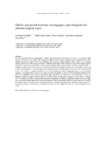Mostrar o rexistro simple do ítem
Ghrelin and growth hormone secretagogues, physiological and pharmacological aspect
| dc.contributor.author | Cordido, Fernando | |
| dc.contributor.author | Isidro, María Luisa | |
| dc.contributor.author | Nemina, Rosa | |
| dc.contributor.author | Sangiao-Alvarellos, Susana | |
| dc.date.accessioned | 2017-06-13T08:28:31Z | |
| dc.date.available | 2017-06-13T08:28:31Z | |
| dc.date.issued | 2009 | |
| dc.identifier.citation | Cordido F, Isidro ML, Nemina R, Sangiao-Alvarellos S. Ghrelin and growth hormone secretagogues, physiological and pharmacological aspect. Curr Drug Discov Technol. 2009;6(1):34-42 | es_ES |
| dc.identifier.issn | 1570-1638 | |
| dc.identifier.issn | 1875-6220 | |
| dc.identifier.uri | http://hdl.handle.net/2183/19167 | |
| dc.description.abstract | [Abstract] The first “growth hormone secretagogues” (GHSs) were discovered by Bowers et al. in 1977. In 1996 the GHSs receptor (GHS-R 1a) was cloned. The endogenous ligand for this receptor, ghrelin, was not identified until 1999. Synthetic molecules termed GHSs are substances that stimulate growth hormone (GH) release, via a separate pathway distinct from GH releasing hormone (GHRH)/somatostatin. Ghrelin displays strong GH-releasing activity through the activation of the GHS-R 1a. Apart from stimulating GH secretion, ghrelin and many synthetic GHSs: 1) stimulate prolactin and ACTH secretion; 2) negatively influence the pituitary-gonadal axis; 3) stimulate appetite and positive energy balance; 4) modulate pancreatic endocrine function and affect glucose levels; 5) have cardiovascular actions. The control of ghrelin secretion is not well established at present, although nutrition is an important regulator. Investigators have exploited the ability of GHSs and ghrelin to release GH by mechanisms different from GHRH as a diagnostic tool, which is the present main clinical use of some GHSs. As an alternative to GH, GH deficient conditions could be treated with any substance which would release endogenous GH, such as synthetic GHSs. It is likely that GHSs, acting as either agonists or antagonists on different pathophysiological processes, might have some other clinical impact and therapeutic potential. At least theoretically ghrelin receptor antagonists could be anti-obesity drugs, as blockers of the orexigenic signal from the gastrointestinal tract to the brain. Inverse agonists of the ghrelin receptor, by blocking the constitutive receptor activity, might lower the set-point for hunger between meals. | es_ES |
| dc.description.sponsorship | Instituto de Salud Carlos III; PI021479 | es_ES |
| dc.description.sponsorship | Instituto de Salud Carlos III; PI051024 | es_ES |
| dc.description.sponsorship | Instituto de Salud Carlos III; PI050983 | es_ES |
| dc.description.sponsorship | Instituto de Salud Carlos III; PI070413 | es_ES |
| dc.description.sponsorship | Xunta de Galicia; PGIDT05PXIC91605PN | es_ES |
| dc.description.sponsorship | Xunta de Galicia; PS07/12 | es_ES |
| dc.language.iso | eng | es_ES |
| dc.publisher | Bentham Science | es_ES |
| dc.relation.uri | http://dx.doi.org/10.2174/157016309787581048 | es_ES |
| dc.rights | The published manuscript is avaliable at EurekaSelect | es_ES |
| dc.subject | Ghrelin | es_ES |
| dc.subject | Growth hormone secretagogues | es_ES |
| dc.title | Ghrelin and growth hormone secretagogues, physiological and pharmacological aspect | es_ES |
| dc.type | info:eu-repo/semantics/article | es_ES |
| dc.rights.access | info:eu-repo/semantics/openAccess | es_ES |
| UDC.journalTitle | Current Drug Discovery Technologies | es_ES |
| UDC.volume | 6 | es_ES |
| UDC.issue | 1 | es_ES |
| UDC.startPage | 34 | es_ES |
| UDC.endPage | 42 | es_ES |
Ficheiros no ítem
Este ítem aparece na(s) seguinte(s) colección(s)
-
GI-FENM - Artigos [119]






